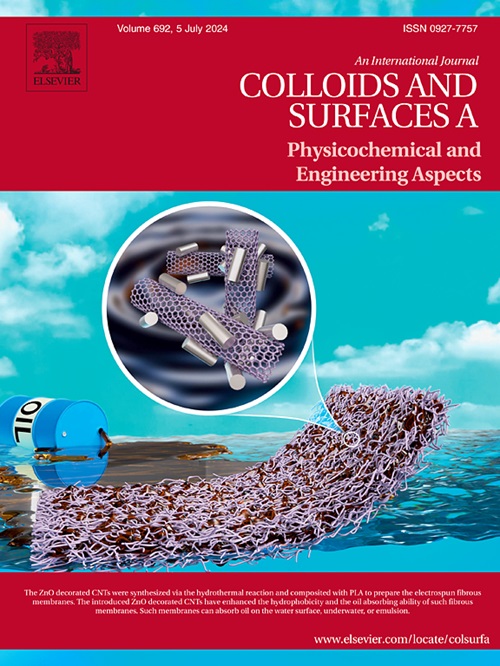Synergistic redox cycling in Cu-montmorillonite anchored CoTiO3: A dual-functional composite for high-efficiency peroxymonosulfate activation toward tetracycline degradation
IF 5.4
2区 化学
Q2 CHEMISTRY, PHYSICAL
Colloids and Surfaces A: Physicochemical and Engineering Aspects
Pub Date : 2025-07-24
DOI:10.1016/j.colsurfa.2025.137855
引用次数: 0
Abstract
Efficient interfacial charge transfer plays a crucial role in for enhancing activation of peroxymonosulfate (PMS) and improving pollutant degradation efficiency. In this study, the interlayer confinement effect of montmorillonite (Mt) with high cation-exchange capacity was utilized to anchor Cu2+ for constructing Cu-intercalated montmorillonite (Cu-Mt), which was further integrated with CoTiO3 (CTO) nanorods to form a CTO@Cu-Mt catalyst. Compared with the single CTO/PMS system, the CTO@Cu-Mt/PMS system exhibited significantly enhanced catalytic performance, with the degradation rate of 98 % within 30 min in tetracycline (TC) degradation. Electrochemical tests showed that Cu species acted as electron transfer mediators and effectively promoted the conversion of Co2+ to Co3+ through its dynamic valence shift, and this synergistic effect significantly enhanced the interfacial charge transfer efficiency. The post-reaction XPS analysis revealed that the Cu+ content exhibited merely a slight decrease of 1.5 % (Δ), confirming the anchoring effect of the interlayer confinement in Cu-Mt on active species, thereby effectively optimizing the Co redox process. Additionally, the Inductively coupled plasma emission spectroscopy (ICP-OES) solution test demonstrated an ultralow Cu leaching concentration of 1.23 mg L−1, further confirming the structural stability of the system. As confirmed by quenching experiments and Electron paramagnetic resonance (EPR) characterization, the efficient degradation of pollutants was primarily attributed to the synergistic interaction of •OH and 1O2. The “structure-limited, dual-path synergistic” design strategy proposed in this study establishes a novel theoretical framework for developing highly stable multiphase catalytic oxidation systems.
cu -蒙脱土锚定CoTiO3的协同氧化还原循环:高效过氧单硫酸盐活化降解四环素的双功能复合材料
高效的界面电荷转移对提高过氧单硫酸根(PMS)的活性和提高污染物降解效率具有重要作用。本研究利用具有高阳离子交换容量的蒙脱土(Mt)的层间约束效应锚定Cu2+,构建cu插层蒙脱土(Cu-Mt),并进一步与CoTiO3 (CTO)纳米棒结合,形成CTO@Cu-Mt催化剂。与单一CTO/PMS体系相比,CTO@Cu-Mt/PMS体系对四环素(TC)的降解率在30 min内达到98 %,显著提高了催化性能。电化学测试表明,Cu作为电子转移介质,通过其动态价移有效地促进了Co2+向Co3+的转化,这种协同效应显著提高了界面电荷转移效率。反应后的XPS分析显示,Cu+含量仅略微下降了1.5 % (Δ),证实了Cu- mt层间约束对活性物质的锚定作用,从而有效地优化了Co氧化还原过程。此外,电感耦合等离子体发射光谱(ICP-OES)溶液测试表明,铜的超低浸出浓度为1.23 mg L−1,进一步证实了体系的结构稳定性。通过淬灭实验和电子顺磁共振(EPR)表征证实,•OH和1O2的协同作用是污染物高效降解的主要原因。本研究提出的“结构限制、双路径协同”设计策略为开发高稳定多相催化氧化体系建立了一个新的理论框架。
本文章由计算机程序翻译,如有差异,请以英文原文为准。
求助全文
约1分钟内获得全文
求助全文
来源期刊
CiteScore
8.70
自引率
9.60%
发文量
2421
审稿时长
56 days
期刊介绍:
Colloids and Surfaces A: Physicochemical and Engineering Aspects is an international journal devoted to the science underlying applications of colloids and interfacial phenomena.
The journal aims at publishing high quality research papers featuring new materials or new insights into the role of colloid and interface science in (for example) food, energy, minerals processing, pharmaceuticals or the environment.

 求助内容:
求助内容: 应助结果提醒方式:
应助结果提醒方式:


